Paradigm Shift
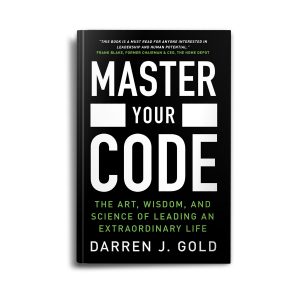 Over the past two decades, there has been a quiet revolution in the fields of psychology and neuroscience challenging two fundamental assumptions. The first is that humans are hardwired to experience emotions and that emotions happen automatically. Unless you’re a saint, if you’ve been honked at by a rude driver, you will have seen this firsthand. You will have experienced reacting in a way that feels completely automatic (and likely regrettable). This is certainly what seems to be happening. The proximity between stimulus (the honk) and reaction (anger) is so close that your perception was that you had no choice but to react in a certain way. To make sense of this experience, you likely have attributed this phenomenon to the myth that humans are emotion- ally hardwired.
Over the past two decades, there has been a quiet revolution in the fields of psychology and neuroscience challenging two fundamental assumptions. The first is that humans are hardwired to experience emotions and that emotions happen automatically. Unless you’re a saint, if you’ve been honked at by a rude driver, you will have seen this firsthand. You will have experienced reacting in a way that feels completely automatic (and likely regrettable). This is certainly what seems to be happening. The proximity between stimulus (the honk) and reaction (anger) is so close that your perception was that you had no choice but to react in a certain way. To make sense of this experience, you likely have attributed this phenomenon to the myth that humans are emotion- ally hardwired.
This is understandable. Early humans who were able to band together effectively increased their likelihood of survival. Evolution favored traits that let people be accepted by and remain part of the clan. In essence, get- ting excluded from the tribe was an almost certain death sentence. As a result, your brain has evolved to recognize threats to your social status and to respond in ways that protect you from risk to your psychological safety. In fact, brain scans show that when you feel excluded or rejected, the part of your brain associated with physical pain—the anterior cingulate cortex—lights up. Hence, as we saw in chapter one, when someone looks at you a certain way or makes a disparaging remark, your amygdala is triggered and institutes a fight/flight/freeze response, releasing the hormone epinephrine and instigating a series of physiological responses. This reaction, known as the amygdala hijack, in turn impairs your most sophisticated mental capabilities—your ability to think rationally, to be creative, to problem solve, to exercise self-control. What started out as an essential survival adaptation—to keep you safe from physical harm or to keep you included in the tribe—has become a major limitation to effectiveness in modern-day life.
So while there may be something to the notion of hardwiring, the truth is far more nuanced and interesting. Your brain is a prediction machine, continuously comparing new stimuli to past experience and making guesses about what action your body should take based
on those comparisons. Beginning in early infancy, your brain begins to construct rules or beliefs for each cate- gory of experience, and they get embedded in your pro- gram. Over time, these rules solidify, and you think it is just the way things are—the way you are wired. Driver honking at you equals someone treating you unfairly, which means you must be angry.
One of the leading researchers in this area, Lisa Feldman Barrett, has arrived at a profound and revolutionary conclusion challenging the myth that humans are hard- wired:
Our emotions aren’t built-in, waiting to be revealed. They are made. By us. We don’t recognize emotions or identify emotions: we construct our own emotional experiences, and our perceptions of others’ emotions, on the spot, as needed, through a complex interplay of systems. Human beings are not at the mercy of mythical emotion circuits buried deep within animalistic parts of our highly evolved brain: we are architects of our own experience.8
The second fundamental assumption being challenged is the view that what you perceive through your senses—primarily sight and sound—dictates the way you feel. In reality, it is mostly the other way around. We touched on this notion in chapter one with the introduction of polyvagal theory—the idea that your central nervous system is constantly scanning your internal state to detect physiological markers that suggest potential threats to your social safety. You continuously experience countless sensations in your body—the result of your glucose levels, breathing rate, lack of sleep, etc. Your brain’s process of registering and integrating changes in
these sensations is known as interoception. Interoception influences what external sensory input you pay attention to. If sleep-deprived and hungry, you will experience the same situation completely differently than you would if well-rested and fed. Again, Barrett does a wonderful job of summarizing this for us:
You construct the environment in which you live. You might think about your environment as existing in the outside world, separate from yourself, but that’s a myth. You (and other creatures) do not simply find yourself in an environment and either adapt or die. You construct your environment—your reality—by virtue of what sensory input from the physical environment your brain selects; it admits some as information and ignores some as noise. And this selection is intimately linked to interoception.9
The implications of this paradigm shift in under- standing human behavior are massive. The sum of your genetics, childhood experiences, culture, neurophysiology (including the anatomy of your brain and, more importantly, your physiological state) all help shape your program and, in turn, how you behave. Your brain uses the rules of your program to make predictions about what actions are most appropriate for any given stimulus. This understanding is revolutionary, and it’s good news. While it is certainly understandable to feel as if certain behaviors are automatic, you nevertheless have the capacity to control every response to every situation. The question now becomes what you can do to master your code (including your physiology) so that the actions you take are more consistent with the choices you would like to make. Since you are truly the architect and author of your experience, you have the possibility (and dare I say responsibility) to create the conditions that will allow you to construct a different way of perceiving and reacting to your circum- stances. The bad news? No more excuses!
 Darren Gold is a Managing Partner at The Trium Group, where he advises and coaches CEOs and leadership teams at many of the world’s most innovative companies, including Roche, Dropbox, Lululemon, Sephora, Cisco, eBay, Activision, and Warner Bros. He is the author of the new book Master Your Code: The Art, Wisdom, and Science of Leading an Extraordinary Life. Learn more at www.darrenjgold.com.
Darren Gold is a Managing Partner at The Trium Group, where he advises and coaches CEOs and leadership teams at many of the world’s most innovative companies, including Roche, Dropbox, Lululemon, Sephora, Cisco, eBay, Activision, and Warner Bros. He is the author of the new book Master Your Code: The Art, Wisdom, and Science of Leading an Extraordinary Life. Learn more at www.darrenjgold.com.










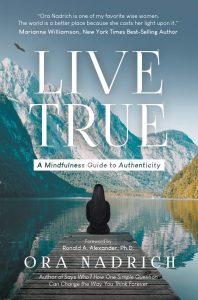 CHAPTER 21: Authenticity
CHAPTER 21: Authenticity Ora Nadrich
Ora Nadrich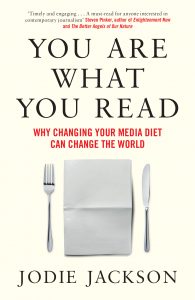
 Jodie Jackson
Jodie Jackson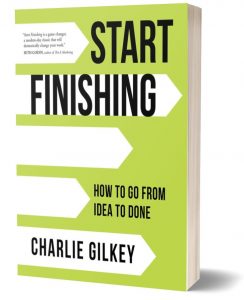 The following is a modified excerpt from Start Finishing: How to Go from Idea to Done.
The following is a modified excerpt from Start Finishing: How to Go from Idea to Done. Charlie Gilkey is an author, entrepreneur, philosopher, Army veteran, and renowned productivity expert. Founder of Productive Flourishing, Gilkey helps professional creatives, leaders, and changemakers take meaningful action on work that matters. His new book is
Charlie Gilkey is an author, entrepreneur, philosopher, Army veteran, and renowned productivity expert. Founder of Productive Flourishing, Gilkey helps professional creatives, leaders, and changemakers take meaningful action on work that matters. His new book is  An excerpt from Beneath the Surface by Kristi Hugstad
An excerpt from Beneath the Surface by Kristi Hugstad Kristi Hugstad is the author of Beneath the Surface: A Teen’s Guide to Reaching Out when You or Your Friend Is in Crisis. Ever since her husband completed suicide in 2012, after years of struggling with clinical depression, by running in front of a train, she has dedicated her life to helping to abolish the stigma of mental illness and suicide. A certified grief recovery specialist, Kristi frequently speaks at high schools. Visit her online at https://www.thegriefgirl.com.
Kristi Hugstad is the author of Beneath the Surface: A Teen’s Guide to Reaching Out when You or Your Friend Is in Crisis. Ever since her husband completed suicide in 2012, after years of struggling with clinical depression, by running in front of a train, she has dedicated her life to helping to abolish the stigma of mental illness and suicide. A certified grief recovery specialist, Kristi frequently speaks at high schools. Visit her online at https://www.thegriefgirl.com.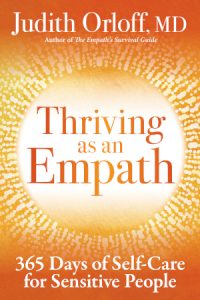 **Excerpted from “Thriving as an Empath: 365 Days of Self-Care for Sensitive People” (Sounds True, Oct. 22, 2019)
**Excerpted from “Thriving as an Empath: 365 Days of Self-Care for Sensitive People” (Sounds True, Oct. 22, 2019) Judith Orloff, M.D., is a New York Times bestselling author, a member of the UCLA Psychiatric Clinical Faculty, and has a Facebook Empath Support Community with more than 6,000 members. She has been featured on The Today Show, CNN, and in Oprah Magazine, the New York Times and more. Her new book,
Judith Orloff, M.D., is a New York Times bestselling author, a member of the UCLA Psychiatric Clinical Faculty, and has a Facebook Empath Support Community with more than 6,000 members. She has been featured on The Today Show, CNN, and in Oprah Magazine, the New York Times and more. Her new book, 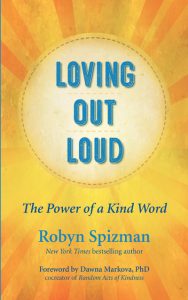 An excerpt from Loving Out Loud by Robyn Spizman
An excerpt from Loving Out Loud by Robyn Spizman Robyn Spizman is the author of
Robyn Spizman is the author of  For those looking toward industries poised to lead the growth charge over the next five-to-ten years, one need look no further than telehealth and telemedicine. These global markets are expected to exceed $185 million from 2019 through 2026, according to the new Advanced
For those looking toward industries poised to lead the growth charge over the next five-to-ten years, one need look no further than telehealth and telemedicine. These global markets are expected to exceed $185 million from 2019 through 2026, according to the new Advanced  For students from K-12 through college-level requiring speech therapy in particular, remote access to professional services and practitioners will clearly become more ubiquitous. In fact, “the demand for speech-language therapists is already outpacing the supply in some cities,” says Licensed Speech Pathologist Orna Kempler-Azulay, president of
For students from K-12 through college-level requiring speech therapy in particular, remote access to professional services and practitioners will clearly become more ubiquitous. In fact, “the demand for speech-language therapists is already outpacing the supply in some cities,” says Licensed Speech Pathologist Orna Kempler-Azulay, president of  An excerpt from LOVE ON EVERY BREATH by Lama Palden Drolma
An excerpt from LOVE ON EVERY BREATH by Lama Palden Drolma Lama Palden Drolma is the author of Love on Every Breath. A licensed psychotherapist, spiritual teacher, and coach, she has studied Buddhism in the Himalayas with some of the most preeminent Tibetan masters of the twentieth century. Following a traditional three-year retreat under his guidance, Kalu Rinpoche authorized her to become one of the first Western lamas. She subsequently founded the Sukhasiddhi Foundation, a Tibetan Buddhist teaching center in Fairfax, California. Visit her online at
Lama Palden Drolma is the author of Love on Every Breath. A licensed psychotherapist, spiritual teacher, and coach, she has studied Buddhism in the Himalayas with some of the most preeminent Tibetan masters of the twentieth century. Following a traditional three-year retreat under his guidance, Kalu Rinpoche authorized her to become one of the first Western lamas. She subsequently founded the Sukhasiddhi Foundation, a Tibetan Buddhist teaching center in Fairfax, California. Visit her online at 